-
solutinos
-
Hire
Frontend Developer
Backend Developer
-
NodeJS Developer
-
Java Developer
-
Django Developer
-
Spring Boot Developer
-
Python Developer
-
Golang Developer
-
Ruby on Rails Developer
-
Laravel Developer
-
.NET Developer
Technology
-
Flutter Developer
-
React Native Developer
-
Xamarin Developer
-
Kotlin Developer
-
Cross-Platform Developer
-
Swift Developer
-
MongoDB Developer
-
C Developer
-
Smart Contract Developers
Cloud
-
-
Services
Mobile Development
Web Development
- Work
-
Multi Services App
-
Food Delivery App
-
Grocery Delivery App
-
Taxi Cab Booking App
-
Multi Services App
-
OTT Platform APP
-
Social Media APP
-
Freelance Service App
-
Car Rental App
-
Medicine Delivery App
-
Liquor Delivery App
-
Sports Betting App
-
Online Coupon App
-
eLearning App
-
Logistics & Transportation App
-
Courier Delivery App
-
On-Demand Real Estate App
-
E-Wallet APP
-
Online Dating App
-
Handyman Services App
-
-
Process
-
Company
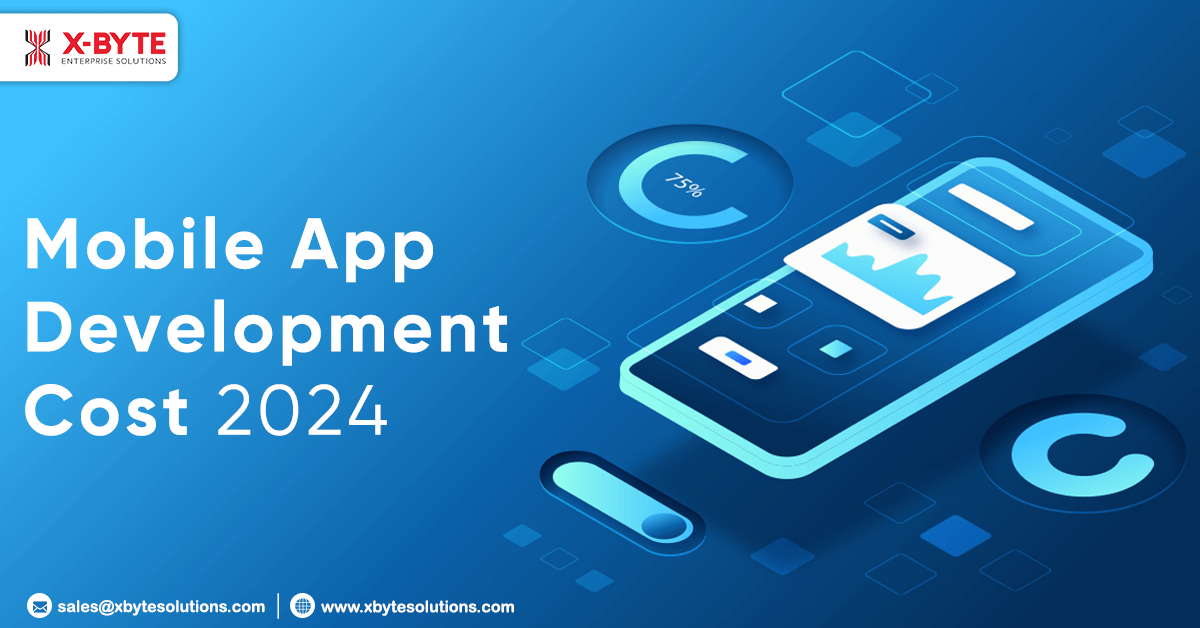
Quick Summary : Mobile App Development Cost breakdowns vary based on app complexity (simple, medium-complex, or advanced apps), features, technology stack, platform, and even the location and expertise level of the development team. The article delves deep into all factors that influence app development costs for Android, iOS, or cross-platform apps and also discusses hidden costs, cost-saving practices, development processes, and revenue models for apps.
Today, mobile apps are one of the topmost touchpoints for customer engagement. Even if you own a physical store, your customers can keep connected to you if you have a standard and sophisticated mobile app that provides immersive features for shoppers. The whole industry 4.0 has grown up around smartphone apps. With ecommerce becoming indispensable for business competitiveness, all traditional brick-and-mortar businesses are also opting for an online presence. And in this endeavor, mobile apps come in handy. Both the App Store and Google Play show no sign of slowing down. Every year thousands of apps are registered on these platforms.
If you are reading this article, you already understand what mobile apps can do to your business’s profitability and therefore, you want to launch a standard, flawless, and engaging mobile app with your industry-specific features. However, you want to research its cost elements to make a prudent decision of hiring a mobile app developer at cost-effective prices. This article is exactly what you are looking for.
We have analyzed the standard costs from top mobile app development companies (small, mid-sized, and large-scale developers) and also platform-wise, technology-wise, and complexity-wise cost factors. This analysis will surely help you understand all the factors that play when deciding mobile app costs in 2024.
So, let's gain insights from real-world examples of app development costs, uncover hidden expenses associated with mobile app development, and explore a step-by-step approach to mobile app development.
Factors Influencing Mobile App Development Cost
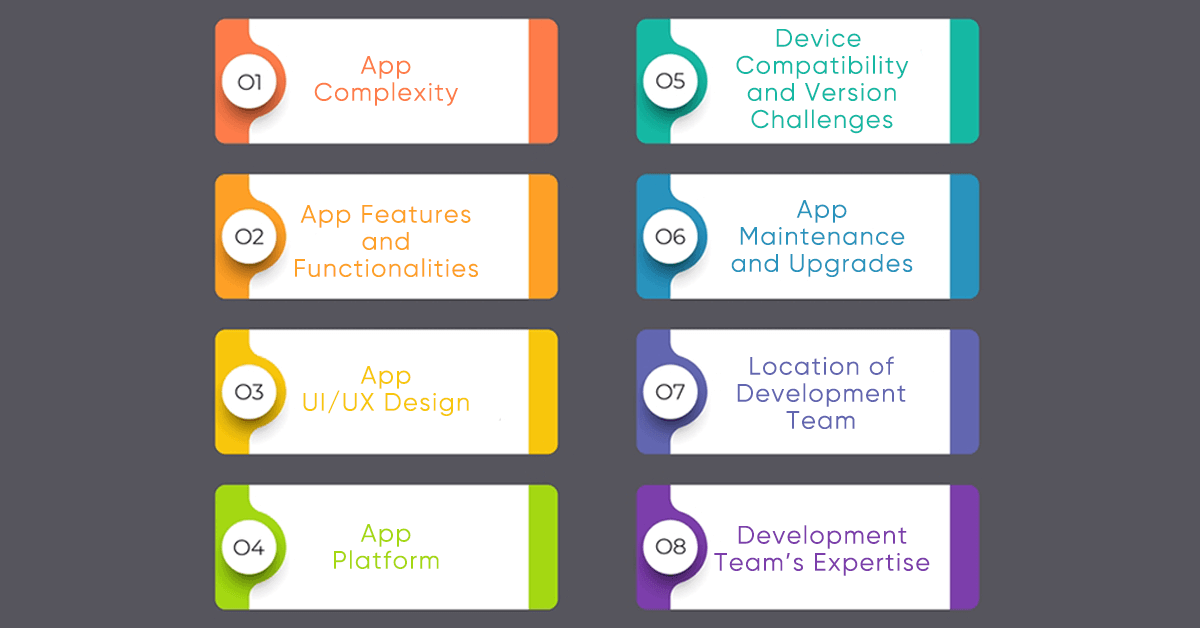
Creating an application is a complicated task that requires significant resources. Investment and efforts. Also, development expertise and technology stack are critical elements when developing mobile apps.
App Complexity
The complexity of a mobile app is a primary determinant of its development cost. Like in any industry, where costs for all products and services vary based on their complexities, mobile apps are no different.
- Basic apps with minimal complexity might cost between $10,000 to $40,000.
- Medium complex apps can cost you between $50000 to $100000.
- Complex applications, such as those with advanced functionalities and integrations, can easily exceed $100,000, reaching up to $550,000.
App Features and Functionalities
Features, functions, integrations, and advanced technologies like real-time tracking, AI integration, AR/VR, etc. impact the costs. The fewer your feature requirements, the less you need to shell out of your pocket.
For example, if you have a fleet of 50 vehicles and want a logistics app with real-time tracking of all your vehicle fleet, it will require more database, server power, and other computations that will increase the work for developers. Functionalities like user authentication or push notifications are considered basic, while advanced features like real-time tracking, blockchain, or IoT integration demand more resources and development time, thus leading to higher costs.
A basic feature mobile app can cost less than $25000, and a medium-featured app will cost you around $50000 to $75000. However, the advanced feature will start at $100000.
Basic Feature Costs:
| Feature | Costs |
|---|---|
| User Login | $500 - $1000 |
| Profile Completion | $900 -$1000 |
| Messaging | $3000-$5000 |
| Push Notifications | $1000-$1500 |
| Basic admin panel | $2500-$4000 |
| File Uploads | $1500-$2000 |
| Search | $1000-$2000 |
Medium Feature Costs:
| Feature | Costs |
|---|---|
| Payments | $2500-$3000 |
| Maps | $3000-$4000 |
| Calls | $4000-$5000 |
| Social Media Integration | $5000-$6000 |
| Offline Access | $3500-$5500 |
| Activity Feed | $2000-$3500 |
| QR Code Scanner | $3000-$4500 |
Advanced Features Costs:
| Feature | Costs |
|---|---|
| Video Calls | $10000 - $12000 |
| Real-time Chat | $4500 - $5500 |
| In-App Purchases | $3500 - $4500 |
| Geofencing | $5000 - $6,000 |
| Augmented Reality | $8000 - $10000 |
| Multi-language Support | $10000-$15000 |
| Customization | $15000- $20000 |
| Conversational Bots | $15000-$25000 |
App UI/UX Design
The UI/UX design and animation are huge differentiators in any app’s engagement. Apps with great features but poor UI/UX can be rejected by users. If you want your app to be a user’s favorite, always hire a mobile app developer with exceptional UI/UX designers.
Now about cost, Prefer custom UI/UX elements with standard and professional layouts that work for a particular industry and its specific audience. The requirement for custom animations and UI/UX elements will ultimately decide the development expenses.
UX/UI designing costs for Apps include:
- User Research & Analysis
- Visual Elements
- Gestures and interactions
- Information Architecture
- Usability Testing
- App Navigation
- Responsive Design
- Wireframing
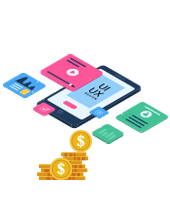
Get an accurate cost estimate for your mobile app development project!
Reach Out Now! Reach Out Now!App Platform
Choosing between platforms like iOS and Android can affect the development costs. iOS apps might involve higher initial costs due to the need for specialized tools and adherence to strict guidelines, whereas Android app development has challenges like the requirement of extensive testing across devices and Android versions.
Developing for both platforms (cross-platform apps) will incur higher costs due to the need for multiple adaptations.
Device Compatibility and Version Challenges
Your app’s cost will go high if it has to be compatible with more devices and versions of operating systems. Android developers face this challenge as there are several Android device makers with multiple screen sizes and Android versions (owing to its open-source nature). Another thing is that if you are using a platform like React Native where the code can be reused for both Android and iOS, then it will result in savings. However, if the app is being developed for a platform that is native (particularly used for Android or iOS only), then it will increase the costs. You will have to get two separate codes for launching the app on both platforms.
App Maintenance and Upgrades
Post-launch maintenance is required to keep apps safe from new cyber threats, and security vulnerabilities. Upgrades are also required to keep the app relevant and updated as per new industry standards, regulations, and user preferences.
App Development companies bill around 15-25% of the initial development expense annually for ongoing maintenance. For instance, if the development cost for a sophisticated application is $150000, it can be approximated that the maintenance cost would be approximately $25000 to $35000 p.a.
Always keep a budget for futuristic needs for your app. Regular updates, new integrations, third-party APIs, bug fixes, and adaptation to new operating systems are ongoing requirements.
Location of Development Team
The expenses are also influenced by the location of the development team. Now, this is certainly a very intricate factor. Why would anyone who wants to develop an app shell an extra amount just because the development team is stationed in a highly developed nation or region?
But this is what it is. Teams in regions with higher living costs, like North America or Western Europe, generally have higher rates compared to those in Asia or Eastern Europe. However, many companies situated in developed nations also have outsourcing partners or offshore offices in Asian countries to cut down the costs for their clients.
Various companies in North America or Western Europe charge $30 to $70 per hour for economic app development, with an average rate of $50 per hour. On the other hand, high-end app development is priced between $80 and $120 per hour, with an average rate of $100 per hour. The rates may go high up to $150 for highly sophisticated app development requiring unique expertise like Bitcoin payment apps, or specialized VR apps for healthcare.
Furthermore, a larger team possessing specialized expertise, years of experience, and an impressive portfolio of previously developed apps will charge higher than their peers. However, you are paying the premium for the guarantee of superior quality and expedited delivery.
Cost Breakdown by App Complexity
| Factors | Simple Apps | Medium Complexity Apps | Complex Apps |
|---|---|---|---|
| Definition | Basic functionalities, minimal features | More features, moderate complexity | Advanced features, high complexity |
| Features | Few app screens, simple functionalities, such as user registration, a simple user interface, and limited administrative features | More app screens, moderate functionalities, custom UI details, and more sophisticated functionalities, which could include social media integrations or payment gateways. | Advanced functionalities, complex interactions, real-time updates, third-party integrations, comprehensive navigation, advanced technologies like AI, ML, Big data, analytics |
| Time of Development | 2 - 4 months | 5 - 7 months | 8 - 12 months |
| Team Size Required | Small team | Moderate-sized team | Large, experienced team |
| Costs Involved | $10000 - $40000 | $50000 - $100000 | $100,000 - $500000+ |
| Cost Bifurcation | Development, design, testing, Minimal backend development, simple UI/UX | Development, design, testing, Backend development, advanced UI/UX | Development, design, testing, Complex backend development, sophisticated UI/UX |
Real-World Examples of App Development Costs
A fair idea of cost estimates for advanced and popular apps in different industries can help you decide the budget allocation for the mobile app development project for your business vertical.
Consider the below table as a benchmark for estimating the development costs and timeframes based on the type of app and its features.
| App Type | Utility and Key Features | Costs of Development | Time Required |
|---|---|---|---|
| Netflix | Media streaming, user profiles, content recommendation | $35,000-$250,000 | 2-6 months |
| Instant messaging, voice/video calls, media sharing | $35000-$90000 | 2-4 months | |
| Uber | Ride-hailing, geolocation, payment integration | $35000-$100000 | 3-6 months |
| TikTok | Video sharing, social media integration | $50000-$150000 | 3-5 months |
| Practo | Healthcare services, doctor appointments, medical records | $50000-$80000 | 3-5 months |
| Photo/video sharing, social networking | $50000-$100000 | 2-4 months | |
| Zoom | Video conferencing, screen sharing, webinar hosting | $50000-$100000 | 3-5 months |
| Duolingo | Language learning, interactive lessons, progress tracking | $20000-$40000 | 2-4 months |
| Spotify | Music streaming, personalized playlists, offline listening | $40000-$100000 | 3-5 months |
| PubG | Online gaming, multiplayer interactions, in-game purchases | $60000-$150000 | 4-6 months |
| Amazon | E-commerce, product search, online transactions | $50,000-$100000 | 3-5 months |
| Agoda | Travel booking, hotel search, reservation management | $30000-$75000 | 2-4 months |
Check out our portfolio of successful app projects across various industries.
Hidden Costs in Mobile App Development
Hidden app development expenses are cost additions that are often not discussed in initial meetings with mobile app development companies. These costs, however, should not be overlooked and kept in mind to get a complete and transparent price quotation for your mobile app development. One reason why any developer won’t tell you these is because these costs are often not fixed and depend on third parties.
For example, your app requires a real-time fetching of a database from third-party services. The annual costs may vary based on subscriptions and your database requirements.
While these costs may not be immediately evident when creating an app, overlooking or underestimating them can be financially disastrous for your budget adherence.
Some examples of hidden costs for mobile app development include;
- Infrastructure costs for networks, servers, hosting, data storage, etc.
- IT support services and continuous technical support costs (variable: as it depends on support required)
- API maintenance and security costs: What will your developer do if your mistake causes your app to be hacked or security issues arise? These costs are variables and will be imposed on you based on the security measures taken.
- When submitting an Android App on the Play Store, you will have to pay a one-time fee of $25.
- Apple, on the other hand, charges $99 per year.
- Marketing costs, if you want your app to be discovered by your target audience
Step-by-Step Mobile App Development Process
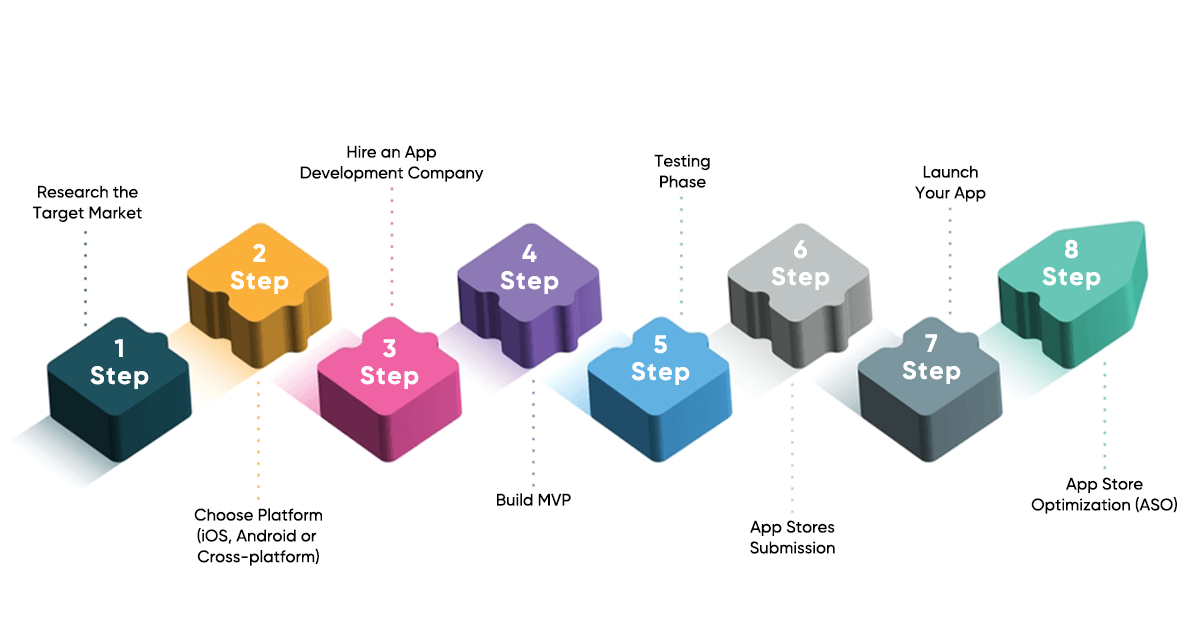
The process of developing a mobile app involves several distinct steps. It is important to allocate a specific amount of money for each stage of app development as discussed below
Research the Target Market
Conducting research on the target market is essential for the success of a mobile app. This research entails analyzing market needs, user preferences, and competition. By undertaking this foundational step, the app can effectively meet the demands of the market and fulfill user expectations.
Choose Platform (iOS, Android or Cross-platform)
Based on your user demographics and market share research, and subsequent discussions with the mobile app developer team, an appropriate platform for app development will be decided. Whether the app will be built on iOS, Android, or cross-platform is critical for business prospects.
Hire an App Development Company
Hiring a trustworthy app development firm not only simplifies the entire process for you but also saves you from headaches like missing deadlines, unwanted excuses, hidden costs, and poor-quality development. of creating an app. Hire a reputable app development service provider with assets, resources, expertise, team, and experience to develop high-quality and industry-compliant apps.
Build MVP
To ensure that your app idea is tested in the real world, creating a Minimum Viable Product (MVP) is a cost-effective strategy. The MVP focuses on essential functionalities to gauge user interest. With MVP, you can collect feedback and ensure that the actual app is flawless and has user engagement issues.
Testing Phase
How will you know that the functionality, usability, and security of the app are up to the mark? The answer is comprehensive testing. The testing phase includes performance evaluation, user interface assessment, bug fixes, glitch detection, and compatibility issues with different devices/operating systems. QA testers will identify and resolve any issues before releasing the app to the public.
App Stores Submission
After the testing phase is finished, the app is sent for approval to various app stores. Approval from platforms such as Apple's App Store and Google Play only comes if you meet specific criteria. For example, Google’s Playstore Guidelines clearly mention the guidelines for App descriptions, App titles, Feature graphics, etc.
Launch Your App
Once the app receives approval, it is released on the specified platforms. Following the launch, it becomes essential to closely observe its performance and user interaction. Analytics tools are utilized to monitor downloads, gather user feedback, and evaluate the overall usage of the app. The information gathered from these metrics is then used to improve the app's features and enhance the user experience.
App Store Optimization (ASO)
Your app will need optimization for SEO purposes to top the results for relevant keywords, Every year, thousands of apps are launched for a particular industry and vertical. ASO helps you in choosing relevant keywords, descriptions, etc. to keep your app on the top of Play Store or Apple Store results. You can also choose influencer marketing to promote your app.
Revenue Models for Mobile Apps
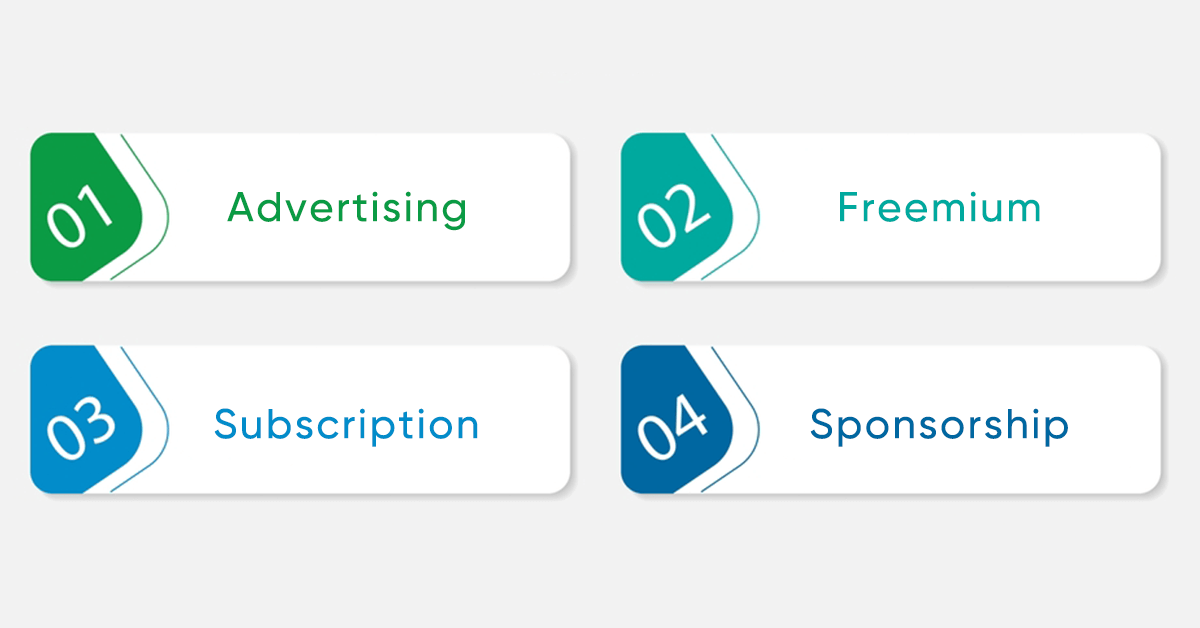
Choosing the best revenue model for mobile app monetization depends on various factors, including the nature of the app, target audience, and monetization goals. If the app offers unique and valuable premium features, the freemium model may be suitable. For media streaming or cloud storage apps, a subscription model could be the best choice. As these apps have newer content every month. Apps with a specific target audience and potential for brand partnerships may benefit from a sponsorship model. Apps with high user engagement and a large user base may benefit from advertising revenue.
- In 2023, 489,000 new apps were downloaded per minute. OTTs for media entertainment command the highest revenue from users followed by social media and dating apps.
- TikTok was the top-grossing app of 2023, generating $2.7 billion in revenue.
- Ad spending in the In-App Advertising market worldwide is forecasted to reach US$352.70bn and per user US$ 53.96 in 2024.
- The average ad spending per mobile internet user in the In-App Advertising market is PUBG Mobile has one of the highest in-app purchase revenues. mobile app worldwide, bringing in $2.01 billion primarily through in-app purchases.
Advertising
You can generate revenue through advertising by partnering with ad networks. You will have to show banner ads for partner networks on your mobile app. However, you can do this only when you have a huge audience. Ad revenue is one of the top monetization methods. For instance, Instagram's ad revenue is projected to exceed $70 billion in 2024 globally, showcasing the immense potential of in-app advertising
Freemium
The freemium model is highly effective if your app has features that users will crave once they use your free versions. In this case, you can ask your users to subscribe to services to use more features or ad-free services. For example, Spotify's freemium model offers a free, ad-supported tier with features like downloading songs.
Subscription
With the Subscription model, you get a steady revenue stream by charging users a regular fee for app access. If you are a service-oriented app like cloud services, billing services, POS software providers, or media streaming services, the subscription model is best for you. Users pay for your app monthly or annually. For instance, Netflix and Disney+ Hotstar have demonstrated the success of subscription-based revenue models in the media streaming industry.
Sponsorship
Sponsorship involves partnering with brands that want to reach the app's user base. These sponsors will offer you money in lieu of their branding or promotions on your app. This model works if you have a niche-specific audience that sponsors want to reach. Unlike regular ads, sponsorships are usually more integrated and less intrusive.
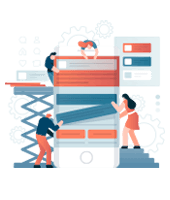
Enhance your app’s user experience with our custom app development solutions
Get in Touch! Get in Touch!Tips for Reducing Mobile App Development Costs
- Adopt Agile Methodologies
- Implement Continuous Integration and Delivery (CI/CD)
- Feature Prioritization
- Emphasize Security
- Plan for Regular Updates
- Engage in Continuous Monitoring
- Consider Cross-Platform Development
- Utilize Open Source Tools and Libraries
- Optimize User Interface and User Experience (UI/UX)
- Leverage Cloud Services
Promote iterative development cycles for flexibility
Automate testing and deployment processes
Identify core features and defer non-critical ones.
Integrate robust security measures from the beginning
Set aside a budget for future app maintenance
Implement monitoring tools for performance optimization
Utilize frameworks like React Native or Flutter for cost-efficiency
Leverage open-source solutions to save time and resources
Invest in user-friendly design from the outset
Utilize scalable and cost-effective cloud solutions
Conclusion
In this guide, we've covered the costs of mobile app development, including factors like complexity, features, design, platform choice, maintenance, and team. Accurate budgeting and strategic planning are crucial for informed decision-making, whether creating a simple app or a complex platform.
Real-world examples and a breakdown by app complexity offer practical insights into the potential financial and resource investment required. We have also revealed potential hidden costs that you need to be aware of to keep your budget in line.
If you need more help deciding costs for your custom app development project, then contact us for expert help and precise estimate for your app development.
Frequently Asked Questions
-
What is the cost to develop an iOS app?
The cost to develop an iOS app can range from $30,000 to $250,000, depending on the app's complexity, design, and functionality. Factors such as the use of advanced iOS features, integration with Apple services, and adherence to Apple's design guidelines can influence the development cost.
-
What is the cost of developing an Android
app?
The cost to develop an Android app is between $30,000 to $250,000. Factors affecting costs for Android apps include device compatibility needs integrations required, UX designs, and stack used.
-
How much does React Native app development cost?
With React Native, organizations have the advantage of writing code only once and utilizing it for both their iOS and Android applications. This results in significant savings of time (25-35%) and resources. The average cost of developing a React Native app can range from $25,000 to $100,000 for simple to mid-level complex apps. Highly sophisticated and advanced React native apps will cost more than $10000.
-
How much does it typically cost to hire an app developer?
Hiring a mobile app developer typically costs between $25 to $100 per hour. However, this will depend on the region from where you are hiring the developer. An app developer from Asian countries like India and China can come at $25-$50 per hour. Native American developers or European developers will charge $50 to $100 per hour.
-
How much does Flutter app development cost?
The average cost to develop a Flutter app ranges between $40,000 to $200,000. Flutter offers a cost-efficient option for building cross-platform applications compared to other frameworks. The framework comes with code reusability. Developers can create applications for multiple platforms using just one codebase.
-
What are the best practices for cost-effective mobile app
development?
The best practices for cost-effective mobile app development include cross-platform development frameworks, agile development methodologies, prioritizing essential features, and hiring an experienced development team.
